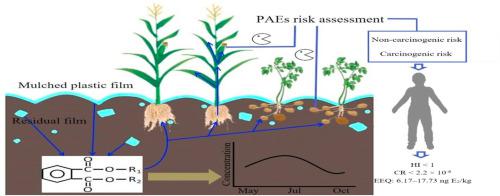Environmental Pollution ( IF 7.6 ) Pub Date : 2021-06-09 , DOI: 10.1016/j.envpol.2021.117546 Dong Wang 1 , Yue Xi 1 , Xiao-Yan Shi 1 , Yu-Jie Zhong 1 , Chao-Li Guo 1 , Ya-Nan Han 1 , Feng-Min Li 1

|
The application of plastic film mulching can greatly improve dryland productivity, while the release of toxic phthalate esters (PAEs) from the plastic film has generated concern. This study investigated the effects of mulched plastic film and residual plastic film on the PAE concentrations in the soil-crop system and assessed the risks to people eating crop products. The PAEs concentration in the 0–25 cm soil layer of plastic mulched farmland was 0.45–0.81 mg/kg, while the average PAEs concentration of 0.37–0.73 mg/kg in non-mulched farmland decreased by 19%. The PAEs concentration in mulched soil reached the highest in July, being 0.80–0.84 mg/kg, while in the non-mulched soil, the PAEs also appeared and gradually decreased from May at 0.62–0.74 mg/kg to October, and the PAEs concentrations were almost the same in the mulched and non–mulched soils at the harvest time in October at 0.37–0.44 mg/kg. With the amounts of residual film in farmland increasing from 0 kg/ha to 2700 kg/ha (equivalent to the total amount of residual film after 60 years of continuous plastic film mulching), the PAEs concentrations were no significant changes, being 0.54–0.93 mg/kg. Maize (Zea mays L.) roots could absorb and accumulate PAEs, and the bio-concentration factor (BCF) was 1.6–2.3, and the average PAEs concentrations in stems, leaves, and grains were 79%–80% of those in roots at 0.77–1.47 mg/kg. For the ingestion of maize grains or potato (Solanum tuberosum L.) tubers grown in plastic film mulched farmland or farmland containing residual film of 450–2700 kg/ha, the hazard index (HI) were less than 1, the carcinogenic risks (CRs) were 2.5 × 10−7 – 2.2 × 10−6, and the estrogenic equivalences were 6.17–17.73 ng E2/kg. This study provides important data for the risk management of PAEs in farmlands.
中文翻译:

地膜覆盖和地膜残留对土壤和植物中邻苯二甲酸酯浓度的影响及其风险评估
地膜覆盖的应用可以大大提高旱地生产力,而地膜中有毒邻苯二甲酸酯(PAEs)的释放引起了人们的关注。本研究调查了覆盖塑料薄膜和残留塑料薄膜对土壤 - 作物系统中 PAE 浓度的影响,并评估了人们食用作物产品的风险。覆膜农田0~25 cm土层PAEs浓度为0.45~0.81 mg/kg,而未覆膜农田的PAEs平均浓度为0.37~0.73 mg/kg,降低了19%。覆盖土壤中PAEs浓度在7月份达到最高,为0.80-0.84 mg/kg,而在未覆盖土壤中,PAEs也出现并从5月到10月逐渐下降,为0.62-0.74 mg/kg,10 月份收获时覆盖和未覆盖土壤中 PAEs 浓度几乎相同,为 0.37-0.44 mg/kg。随着农田残膜量从0 kg/ha增加到2700 kg/ha(相当于连续覆膜60年的残膜总量),PAEs浓度无显着变化,为0.54-0.93毫克/公斤。玉米 (Zea mays L.) 根能吸收和积累PAEs,生物富集因子(BCF)为1.6-2.3,茎、叶和籽粒中PAEs平均浓度为0.77的79%-80% –1.47 毫克/公斤。摄入地膜覆盖农田或残膜农田中生长的玉米粒或马铃薯(Solanum tuberosum L.)块茎含450-2700 kg/ha残膜,危害指数(HI)小于1,致癌风险(CRs) ) 为 2.5 × 10 -7 – 2.2 × 10 -6,雌激素当量是 6.17–17.73 ng E 2 /kg。本研究为农田PAEs风险管理提供了重要数据。










































 京公网安备 11010802027423号
京公网安备 11010802027423号